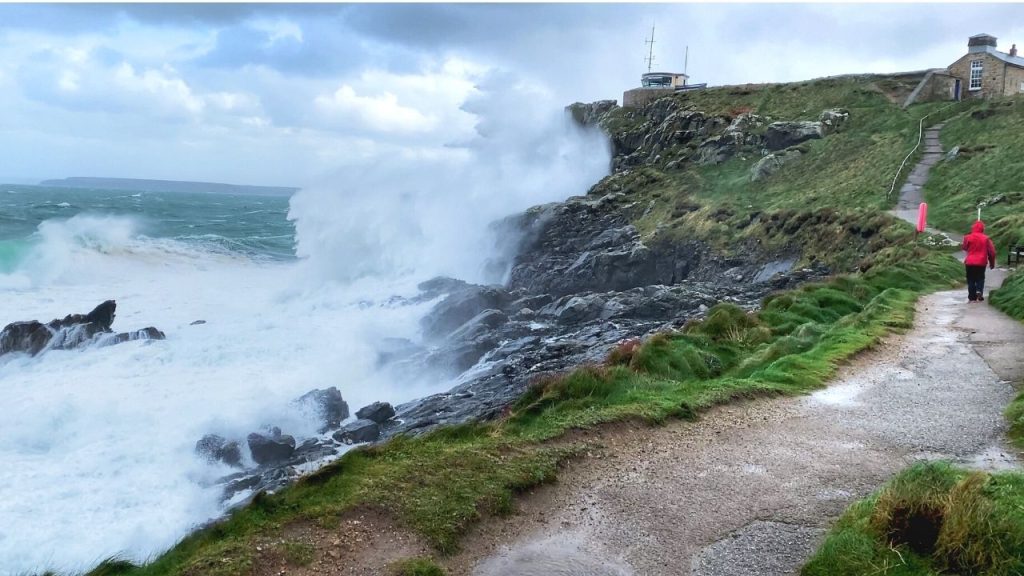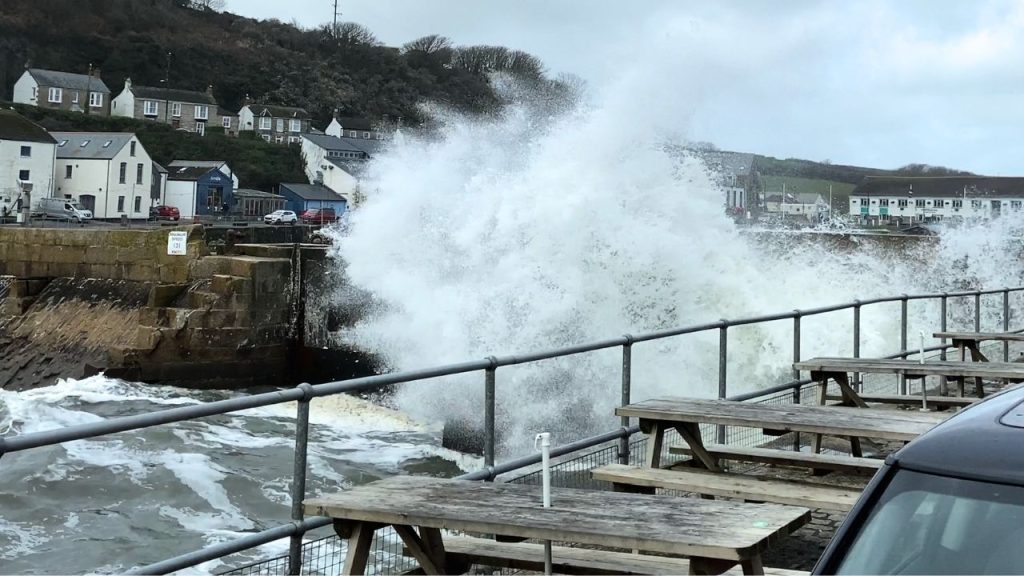Over the past ten years, Cornwall and the UK as a whole has faced numerous named storms, powerful Atlantic systems that have brought strong winds, heavy rain, flooding, and occasionally snow or ice.
The Met Office began naming storms in 2015 to improve public awareness of severe weather and encourage preparedness. Below is an overview of some of the most significant storms to impact Cornwall and the UK over the past decade.
Storm Abigail (November 2015)
Storm Abigail was the first storm ever named under the UK and Ireland’s new naming scheme. It mainly affected northern and western Scotland with strong winds, heavy rain, and lightning. Schools closed, power lines were damaged, and ferry services were disrupted. It marked the start of a more public-facing approach to storm awareness.
Storm Ciara (February 2020)
Storm Ciara brought widespread disruption across the UK, with gusts of up to 97 mph recorded on the Isle of Wight. Heavy rainfall led to flooding in many parts of northern England and Wales. Thousands of homes lost power, and travel networks were heavily affected. The storm was followed closely by another, worsening conditions in many regions.
Storm Dennis (February 2020)
Arriving less than a week after Ciara, Storm Dennis delivered yet more rain and strong winds. Some areas received over 150mm of rainfall, and flooding affected homes, roads, and rail lines across the country. River levels reached record highs, and emergency services worked around the clock to manage the impact.
Storm Ellen (August 2020)
Unusual for its timing, Storm Ellen struck in late summer, bringing gusts of 60 to 70 mph across exposed coastal areas. Strong winds and large waves caused significant coastal damage and power outages. The storm also brought tragedy when a holidaymaker died off the Cornish coast, highlighting the dangers of rough seas even outside winter.
Storm Alex (October 2020)
Storm Alex arrived in early October, bringing torrential rain and blustery conditions across much of the UK. The 3rd of October became the wettest day on record for the country, with an average of 31.7mm of rainfall nationwide. Flood warnings were issued across southern England and Wales, and travel was affected by surface water and strong winds.
Storm Bella (December 2020)
Striking over the Christmas period, Storm Bella brought gusts exceeding 100 mph in some areas and widespread heavy rain. Flooding and power cuts occurred across the country, with coastal regions such as Cornwall experiencing high waves and dangerous sea conditions. It was a stormy end to an already unsettled year.

Storm Darcy (February 2021)
Storm Darcy brought cold easterly winds and widespread snow to much of the UK, especially in the southeast and eastern England. The snow caused travel disruption and bitterly cold conditions, earning the nickname “The Beast from the East 2” in some places. While Cornwall saw less snow, temperatures remained notably low for several days.

Storm Christoph (January 2021)
Storm Christoph delivered heavy rainfall and flooding to parts of northern England, North Wales, and the Midlands. Some areas recorded over 100mm of rain in just a couple of days. Homes were evacuated due to rising river levels, and emergency services were deployed to assist with flood defences.
Storm Arwen (November 2021)
Storm Arwen was one of the most damaging storms in recent memory, bringing unusually strong northerly winds, snow, and widespread power cuts. Gusts reached nearly 100 mph in parts of northern England, and millions of homes were left without power for days. The storm caused extensive tree damage and several fatalities.

Storm Dudley (February 2022)
Storm Dudley was part of a trio of storms that battered the UK in February 2022. It brought strong winds, particularly across Scotland and northern England, causing power outages and travel disruption. Though not the most severe of the three, it set the stage for the much stronger systems that followed.
Storm Eunice (February 2022)
One of the most powerful storms in recent history, Storm Eunice caused red weather warnings for the first time in parts of southern England. Gusts of 122 mph were recorded at The Needles on the Isle of Wight — a record for England. Roofs were torn off buildings, trees uprooted, and transport networks were heavily disrupted. Cornwall, along with much of the southwest, saw significant coastal waves and damage.

Storm Franklin (February 2022)
Following directly after Eunice, Storm Franklin brought further strong winds and heavy rain. With already saturated ground, flooding became widespread in Yorkshire, Shropshire, and Worcestershire. Hundreds of properties were flooded, and rail services were cancelled due to debris and high water levels.

Storm Mathis (March 2023)
Storm Mathis affected southern England and Wales in late March 2023. It brought heavy rain, strong gusts nearing 70 mph, and localised flooding, particularly along coastal regions. The storm was notable for its late-season arrival and the strong winds it generated across the south-western counties, including Cornwall.

Storm Agnes (September 2023)
Storm Agnes was the first named storm of the 2023–24 season. Moving across Ireland and western parts of the UK, it brought gusts of up to 80 mph and heavy rain, particularly around the Irish Sea and Cornwall’s exposed coastline. While the storm moved through quickly, it caused travel disruption and reminded many that storm season had begun in earnest.

Storm Bert (November 2024)
Storm Bert hit the UK in late November 2024 with strong winds, snow, and icy conditions in northern areas. Travel was disrupted as temperatures dropped, though southern parts of the UK, including Cornwall, mainly saw rain and blustery weather. It marked the start of another active winter period.
Storm Éowyn (January 2025)
Storm Éowyn brought the most powerful winds recorded in the UK in over a decade. The storm caused widespread damage, power cuts to over a million homes, and dangerous travel conditions. Coastal regions again bore the brunt of the gusts and large waves. It served as a reminder of how severe winter storms can still be in an era of changing climate patterns.
Looking Ahead
In the decade since storm naming began, the UK has experienced a growing number of intense weather events. These storms have highlighted the country’s vulnerability to strong Atlantic systems and the importance of preparedness, particularly in coastal areas such as Cornwall.
The naming system itself has proven effective in raising public awareness and helping people take action before bad weather hits. Patterns are also emerging, storms are sometimes arriving in clusters, compounding their impact, and warmer global temperatures may be influencing their frequency and intensity.
For Cornwall, where exposed headlands and coastal towns face the full force of Atlantic winds, each storm season brings both challenges and reminders of nature’s power. Whether it’s high seas battering the coast or strong winds sweeping inland, staying alert to weather warnings and respecting the sea remains as important as ever.
Love watching storms in Cornwall? You can watch my entire YouTube video playlist here
